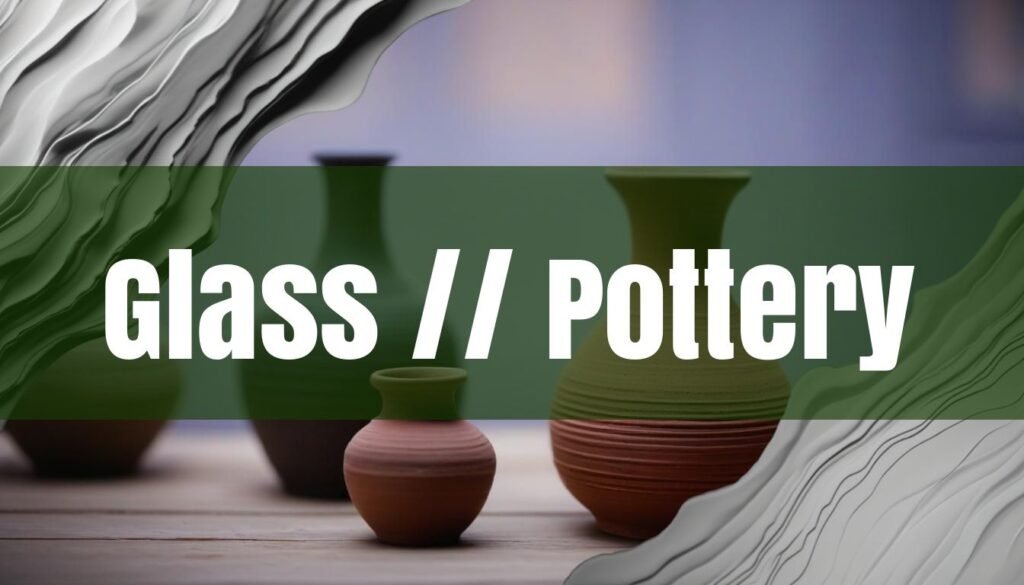Transforming ordinary glass objects into pieces that mimic the rustic charm and tactile appeal of pottery is a creative endeavor that opens up a world of artistic possibilities. By employing a variety of techniques, one can effectively blur the lines between these two distinct mediums, achieving a look that marries the elegance of glass with the earthy character of pottery. Whether you’re aiming for a subtle nod to ceramic textures or a complete visual transformation, understanding the right methods is key.
Creating Pottery-Like Textures on Glass
Achieving a pottery-like texture on glass involves several approaches, each offering a unique effect. Surface texturing is a primary method, where the smooth, glossy surface of the glass is altered to resemble the matte finish of ceramic. This can be accomplished through techniques like etching and sandblasting. Etching creams, readily available at craft stores, can be applied to glass surfaces to create a frosted effect, which diffuses light and reduces the glass’s inherent shine. Sandblasting, on the other hand, uses abrasive particles to physically texture the glass, providing a more pronounced matte finish. Both methods offer a blank canvas for further embellishments, such as painting or layering. For those interested in incorporating actual glass into ceramic pieces, Lakeside Pottery recommends firing glass to Cone 6 in an electric kiln after bisque firing the pots to Cone 06. They also emphasize documenting glass sources, as different sources can yield varied results after firing. If you are interested in learning more about kilns, consider reading Kiln Types: Electric, Gas, and Wood-Fired Explained. You may also be interested in Firing Temperatures: A Potter’s Guide.
Painting Techniques for a Pottery Effect
Painting is another essential technique in mimicking the appearance of glazed pottery on glass. Acrylic paints are a versatile option, allowing for a range of finishes from matte to glossy, depending on the desired effect. Faux finishing methods, commonly used in decorative painting, can be adapted to glass to replicate the nuances of ceramic glazes. This might involve layering different colors to create depth, using sponges or rags to apply paint unevenly for a mottled effect, or employing techniques like stippling or dry brushing to add subtle textures. To further enhance the visual texture, consider creating crackle effects, which are characteristic of some types of pottery glazes. Crackle medium can be applied between layers of paint, causing the top layer to crack as it dries, revealing the color underneath. Metallic accents, such as gold or bronze, can also be incorporated to give the piece an aged, antiqued pottery aesthetic. Renovated Faith suggests that because spray paint is oil-based, it is a much better option than acrylic paints for glass. They recommend Rustoleum Chalked Spray Paint for a nice matte chalk finish. DecoArt Glass Paint is also recommended for exceptional coverage and durability on glass and glazed ceramics. Your Decorative Painting Resource suggests that enamel paint can be used on glass and any other glossy or non-glossy surface, specifically FolkArt Enamel Paint by Plaid Enterprises or Americana Gloss Enamels.
Advanced Techniques and Safety Considerations
For those looking to take their glass-to-pottery transformation to the next level, molds and applied clay can offer additional possibilities. Using molds, one can create glass shapes that closely resemble traditional pottery forms, such as vases or bowls. These molded glass pieces can then be further treated with the texturing and painting techniques mentioned earlier. Alternatively, polymer clay can be applied to the surface of the glass to create raised patterns, textures, or even handles, mimicking the look of hand-thrown pottery. Once the clay is baked and hardened, it can be painted to blend seamlessly with the glass surface. When working with glass and heat, it’s crucial to understand the firing temperatures and annealing processes involved. Glass work is normally done in an electric kiln at temperatures lower than ceramic firing, usually around 1300 – 1500 degrees Fahrenheit. The main difference between a glass kiln and a ceramics kiln is that glass kilns fire from the top down to get an even heat, while ceramic kilns fire from elements around the kiln to heat the objects evenly. Moreover, safety should always be a top priority. When fusing glass onto pottery, remember that all items made with glass are NOT FOOD SAFE and should be used for decorative purposes only. Always ensure adequate ventilation when working with paints, etching creams, and other chemicals, and wear appropriate protective gear, such as gloves and eye protection, to prevent skin and eye irritation.





